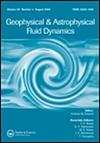关于羽流的数学理论
IF 1.1
4区 地球科学
Q3 ASTRONOMY & ASTROPHYSICS
Geophysical and Astrophysical Fluid Dynamics
Pub Date : 2023-03-04
DOI:10.1080/03091929.2023.2187054
引用次数: 0
摘要
我们重新考虑Schmidt (1941a,b)提供的紊流羽流形成理论及其积分公式,特别是Morton等人(1956)的理论。正确表述数学理论的一个特殊问题是,羽流的宽度是有限的还是无限的,以及夹带速率是规定的还是推导出来的。Fox(1970)表明,羽流的夹带率可以通过使用积分矩理论从控制偏微分方程中推导出来,提供了速度和浮力剖面的假设表达式,但是如果羽流被认为是无限宽的(可能适合层流羽流),是否需要规定夹带率就不太清楚了。这里我们选择了一种旋涡黏度模型,它与以前使用的模型不同,它允许旋涡黏度随垂直速度而消失。然后,我们表明,对于描述这种羽流在非分层介质中上升的相似解的常微分方程,它们的解意味着羽流是有限的,并且羽流边缘的携带速率是模型公式的结果,不需要假设;结果表明,由此确定的夹带系数与实验结果一致。我们还表明,由于遗漏了高斯尾,所得的速度分布与实验发现的速度分布不同,我们建议,这种差异可以通过包含小分子运动粘度在模型中得到解决。本文章由计算机程序翻译,如有差异,请以英文原文为准。
On the mathematical theory of plumes
ABSTRACT We reconsider the theory of turbulent plume formation provided by Schmidt (1941a,b) and its integral formulation, particularly that of Morton et al. (1956). A particular issue for the correct formulation of a mathematical theory is whether the plume is taken to have finite or infinite width, and whether the entrainment rate is prescribed or deduced. Fox (1970) showed that the entrainment rate for a plume can be deduced from the governing partial differential equations by the use of integral moment theory, providing one assumes expressions for the velocity and buoyancy profiles, but it is less clear if entrainment needs to be prescribed if the plume is taken to be of infinite width (as might be appropriate for a laminar plume). Here we choose an eddy viscosity model of a plume which differs from those previously used by allowing the eddy viscosity to vanish with the vertical velocity. We then show that for the ordinary differential equations describing the similarity solution for such a plume rising in an unstratified medium, their solution implies that the plume is finite, and that the entrainment rate at the plume edge is a consequence of the model formulation, and does not need to be hypothesised; and we also show that the entrainment coefficient which is thus determined is consistent with values obtained by experiment. We also show that the resulting velocity profiles differ from those found experimentally by their omission of the Gaussian tail, and we suggest that this discrepancy may be resolved in the model by the inclusion of the small molecular kinematic viscosity.
求助全文
通过发布文献求助,成功后即可免费获取论文全文。
去求助
来源期刊

Geophysical and Astrophysical Fluid Dynamics
地学天文-地球化学与地球物理
CiteScore
3.10
自引率
0.00%
发文量
14
审稿时长
>12 weeks
期刊介绍:
Geophysical and Astrophysical Fluid Dynamics exists for the publication of original research papers and short communications, occasional survey articles and conference reports on the fluid mechanics of the earth and planets, including oceans, atmospheres and interiors, and the fluid mechanics of the sun, stars and other astrophysical objects.
In addition, their magnetohydrodynamic behaviours are investigated. Experimental, theoretical and numerical studies of rotating, stratified and convecting fluids of general interest to geophysicists and astrophysicists appear. Properly interpreted observational results are also published.
 求助内容:
求助内容: 应助结果提醒方式:
应助结果提醒方式:


